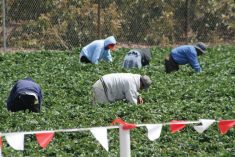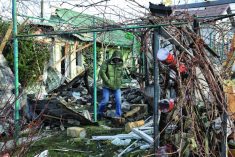The shipping container mess created by the pandemic will likely last until at least 2022, says the vice-president of a West Coast container transloading company.

“Steamship lines across the globe are all playing catch-up with the import movements from across Asia and North America,” said Jordan Atkins, vice-president of WTC Group in New Westminster, B.C. “Even with vessels that would normally take a certain percentage of loaded containers out of North America, that’s been shifted to repo empty containers from North America back to China and southeast Asia, instead of carrying export goods.”
And there’s no mystery why companies are unwilling to wait for containers to be filled with pulses, special grains or other products.
“They are getting five to seven to up to 10 times the revenue for a China-to-Canada, or China-to-the-U.S. move, as they are for the opposite (direction),” said Atkins.
Read Also

Moo translator and methane measures: There’s an app for that
Dalhousie University researchers use artificial intelligence to create new dairy farm apps that analyze cattle sounds and measure methane.
“It’s more profitable for them to move an empty container out of North America back to China (and) get it in line to take another premium load quicker than it is to take our loads over there, unload them, and put the container back into circulation.”
The focus on China and southeast Asia has made it more difficult to ship to other areas.
The Indian subcontinent is one area where there are capacity restrictions on ocean carriers. There are no direct routes from Canada to the Indian subcontinent, he said.
Each trip from Vancouver must stop at other ports, and these ports are full of product that is going from China to Europe, said Atkins. Any route that has multiple stops (called a transshipment) is much more expensive.
“The median container price that they are paying to get through is US$15,000,” he said. “The price that Canadian farmers are typically looking to move from Canada into the Indian subcontinent is less than 20 per cent of that.
“(This) has been really good for the bottom line of the ocean carriers, not so good for anybody looking to export from any other region in the world because you can’t compete with those kind of numbers.”
The start of the pandemic initially slammed the movement of goods as factories closed and consumers worried about their financial prospects cut back on spending. But by the last quarter of 2020, the situation had reversed and demand for Asian goods has continued to be high ever since. There is also a huge backlog of imports coming to North America, said Atkins.
“It’s turned the whole industry on its head, and reorganizing supply chains,” he said. “Containers are not even being brought to inland areas anymore because the steamship lines have made it so prohibitively expensive.”
Prior to COVID-19, the freight rate for a container going from Shanghai to Vancouver was $3,000 to $4,000 — now it’s $20,000, said Morgan King, regional manager for Western Canada with Manitoulin Global Forwarding. The price on the backfill route used to be $400 to $800 for a container to Shanghai. Now it’s around $1,000 to $2,000.

“Freight rates are anywhere from five to 10 times their previous highs,” said King. “The reality is they don’t make a lot of money on that container going back to China.
“The hard part is that we have importers who aren’t able to get as much as they want, especially importers who are importing low-value product. It’s just out-of-control expensive for them.”
When carriers aren’t taking exports, that makes it hard for Canadian exporters to get their product out, whether that product is a crop or a machine, he said.
And good luck trying to get a container east of the Rockies.
Containers used to come from China and go to stations in places such as Saskatoon or Calgary, but the ocean transport companies are pricing so high now, it’s almost too expensive to bring it to these areas. Some exporters in North America must bring their containers to Vancouver, unload it, put it into a domestic container and turn that back around.
“So domestic carriers and transload has really increased over the last six months,” said King.
That has a big impact on businesses such as Sakai Spice in Lethbridge, which primarily exports mustard flour made in Lethbridge to Japan.
“Our company is still moving products” said Sakai Spice president Dave MacFarlane. “That hasn’t stopped. We have less choice in terms of competition, to some destinations, especially these transshipment ones.
“We’re at their mercy, they can charge us whatever they want, they sail whenever they want, they give us the level of service they want and things that used to take 60 to 65 days to their destination are now 120. There’s not much we can do about it because there’s no competition.”
Currently his company is managing to source empty containers from Calgary, which are shipped by rail to a container yard in Lethbridge. Once filled, they go back to Calgary and then to Vancouver for ocean transport. But MacFarlane is preparing for alternatives.
“We might have to find a way to get our products to Vancouver by some other means of conveyance, where they will then be put into the container,” he said. “Many companies have done that in the past, but more with raw grain products. We have a manufactured product.
“We can do it, and we will do it, and we’ve got the logistics figured out. But it’s not the ideal situation.”
But it’s one everyone might have to live with for a while.
Atkins said the situation will not be resolved until there are fewer COVID-19 outbreaks and disruptions to the supply chain. He said he is not sure if policy from government or legislation will be able to solve the problem.
















